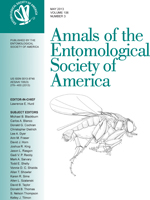The northern corn rootworm (Diabrotica barberi Smith & Lawrence) in eastern and central North America exhibits at least three distinct populations with respect to Wolbachia infection: uninfected, singly infected, and multiply infected. The infected states are associated with different mtDNA haplotypes and reduced mtDNA variability. The previous results demonstrated that the major mtDNA clades of D. barberi were infected with different variants of Wolbachia; however, the total amount of Wolbachia diversity was substantially underestimated. Here we report sequences of the Wolbachia wsp surface protein gene indicating that multiple infections are present. Analysis of the wsp sequences establishes the existence at least five distinct wsp variants. The recovery frequency of specific wsp hypervariable regions (HVR) obtained from several individuals was unequal. The most common was obtained 33 times, the least common only once. One of the Wolbachia variants was present in both singly infected and multiply infected individuals. A possible explanation for the frequency differences are that the frequency of each variant is not the same within each insect. An alternative possibility is that not all individuals are infected with all five variants and that different animals contain different combinations of the variants. The second scenario suggests that some variants are rare in the population. Comparisons of the wsp genes with sequences in GenBank show that two of the variants are most similar to variants infecting subspecies of the congeneric western corn rootworm (Diabrotica virgifera virgifera LeConte and Diabrotica virgifera zeae Krysan & Smith). Individual wsp HVRs were also aligned with GenBank sequences. The results provide evidence that some HVRs are much more common than others and that the HVRs can be shuffled to create new wsp genes.
How to translate text using browser tools
1 May 2013
Wolbachia wsp Gene Clones Detect the Distribution of Wolbachia Variants and wsp Hypervariable Regions Among Individuals of a Multistrain Infected Population of Diabrotica barberi (Coleoptera: Chrysomelidae)
Richard L. Roehrdanz,
Sheila G. Sears Wichmann
ACCESS THE FULL ARTICLE
It is not available for individual sale.
This article is only available to subscribers.
It is not available for individual sale.
It is not available for individual sale.
endosymbiont
mtDNA
population boundary
rootworm
Wolbachia surface protein





